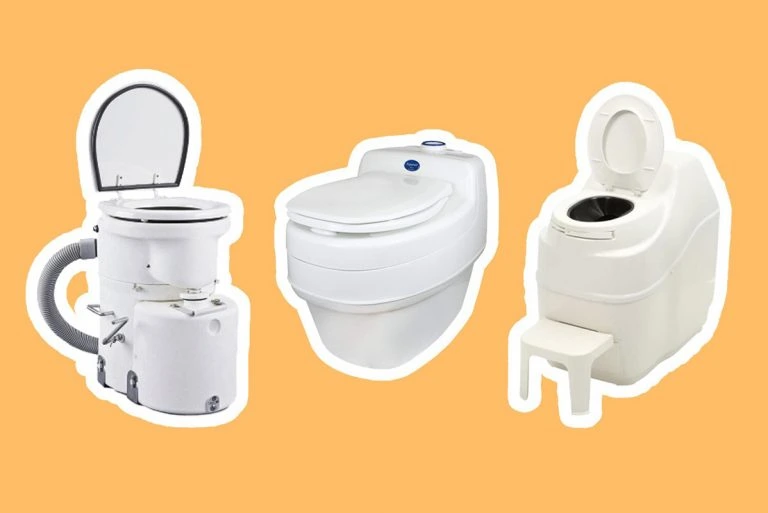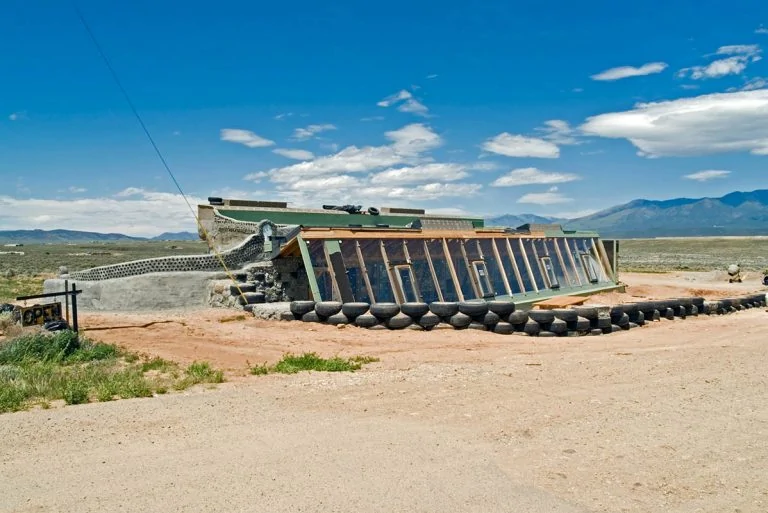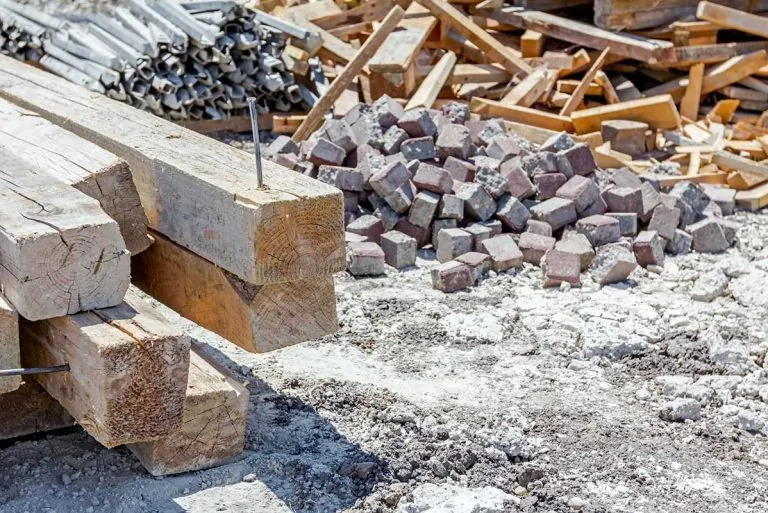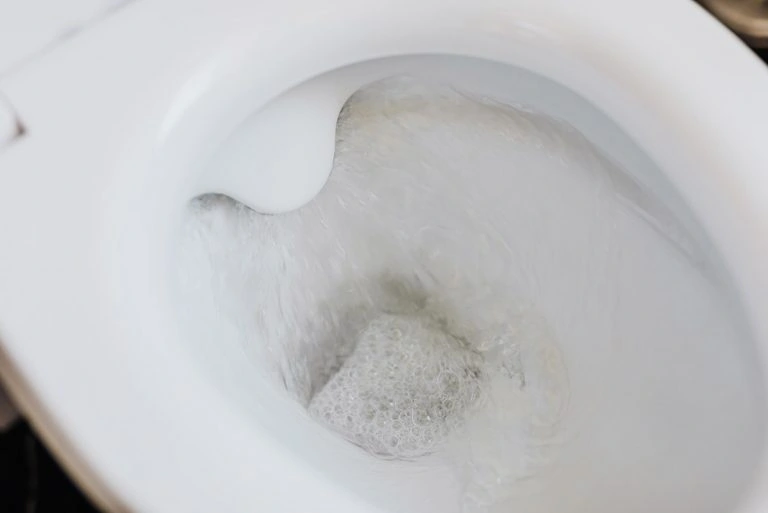Off-grid living has its own distinct set of challenges. Choosing one of the best composting toilets will help enormously, saving you water, money, and a whole potential host of sewage and septic tank issues.
Best composting toilets
Here is our selection of the top composting toilets on the market. Whatever your priorities, you’ll find the best composting toilet for your home, boat, or RV right here.
1. Nature’s Head Self Contained Composting Toilet
Nature’s Head Toilet with spider handle is one of the most popular composting toilets on the market. Durable, reasonably priced, and easy to install, if you’re looking for a self-contained, urine-separating dry toilet, this model is hard to beat.
Originally designed for the marine environment, this unit is ideal for places where you don’t have plumbing or even electricity. Its low-volume air circulation fan runs off 12V, so it’s ideal for solar or other battery setup. This ensures no odors, and that the air in your bathroom is permanently recycled.
Thanks to its agitator spider handle for mixing your compost, you won’t need a lot of space for this model. The solid waste bin needs emptying every 90 uses (approximately), so around 4-6 weeks for two users.
Emptying takes just five minutes and the whole system is very simple and easy to use.
What we like:
- Easy to install – simply place it where you need it, connect the ventilation hose to the outside and power the fan. No sewer connection or water supply is required.
- Space-saving design – Thanks to its spider handle, it’s ideal for small spaces. You can even mount the handle on either side.
- Simplicity – With its two waste separation bins and easy empty system, this unit is simple but highly effective. Its simplicity makes for greater reliability and versatility.
- Air circulation fan – Keep your bathroom air fresh and recycled with the air circulation fan. It has a low draw and you don’t need to have it running to use your toilet.
What we don’t like:
- Ships with 12V connection only – if you want to run the fan off mains power, you’ll need to order a 110V transformer.
- Hard to tell when the urine bin is full – unfortunately you may experience a few overflows when getting used to this model. The urine bin will need emptying frequently and you’ll have to pull it out to check regularly.
Easy to install and maintain, this model by Nature’s Head makes a great option. You can order a 110V transformer for use with your mains power or even use it without the fan if you have no on-site power, making it one of the most versatile models around.
2. Separett Villa 9215 Urine Separating Toilet
One of the most attractive compostable toilets around, the Villa 9215 is also one of the best models if you’re a little squeamish about the idea of dealing with your waste. Thanks to its pressure-activated seat, the solid waste bin remains concealed when your toilet is not in use, and no manual turning is required for an even distribution.
In terms of design and appearance, this model is very similar to a regular toilet and it is also easy to use and clean. The solid waste is contained in a liner, so you won’t have to see the contents of your solids bin. Average family use requires emptying approximately every six weeks.
You don’t have a urine container as standard to empty with this model – your urine is plumbed to a holding tank or grey-water system and the fan keeps your toilet smelling fresh.
What we like:
- Attractive design – this composting toilet looks and feels very much like a regular toilet. Its exterior is similar in appearance to porcelain.
- Pressure-activated seat – sit down to open the toilet’s screen, otherwise, the solid waste bin remains concealed. The container also automatically rotates slightly for an even distribution.
- Low maintenance – you don’t have a urine container to empty and the waste container does not need turning. Simply remove the compostable bin liner approximately every three weeks.
- Fan – with adapters for both AC and DC power, the fan can vent up to 20 feet and keeps odors at bay.
What we don’t like:
- Installing urine line out – this can make placement a little trickier than with other models, requiring some drilling. However, running a line outside to a holding tank means less frequent emptying.
If you are looking for a hands-off composting toilet, then the Villa by Separett is an excellent choice. While it can take a little more planning and effort to install, its low maintenance, good looks, and generous capacity make it well worth it.
3. Air Head Composting Toilet
If you need a compact composting toilet, check out the Air Head. Its circular design complete with a round solids tank not only saves space, it also makes for easier cleaning.
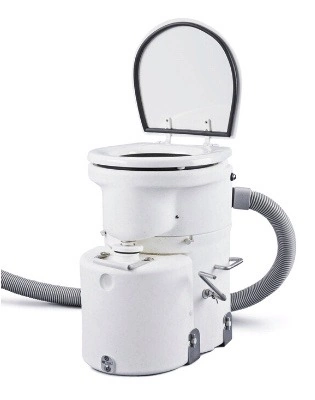
Fully self-contained, this highly reliable composting toilet uses high-quality stainless steel hardware for extra durability, and has no rubber moving parts. Urine flows forward into the liquid tank that can be independently removed and emptied. Use the side lever to open the solid tank which can contain approximately 80 uses.
You can purchase additional tanks for increased capacity, ideal for larger families with small bathrooms. The fan draws air over your waste, helping with composting and ensuring excellent ventilation.
What we like:
- Compact circular design – ideal for small spaces, you get a good capacity unit that will fit almost anywhere thanks to its circular design.
- Superior odor control – with two screen vent holes and a small fan your solid waste dries out well to improve composting and minimize odors. Air inside your bathroom is also permanently recycled.
- Infrequent solids emptying – can last two users for up to one month. Add extra solids tanks for even greater capacity.
What we don’t like:
- Daily urine emptying – you’ll need to empty the urine tank daily for couples, or several times if you are a family.
With its easy-to-clean, practical design, and relatively good looks, no wonder the Air Head is a highly popular model wherever space is of a premium. Fully self-contained, with a large solid tank capacity, this compact composting toilet is definitely a top choice.
4. C-Head Basic Composting Toilet
Looking for a composting toilet at a good price with plenty of options to suit your specific setup? C-Head is a customer-friendly company that prides themselves on their high levels of support and product quality.

The Basic model takes up more space than their Shorty or Corner styles, however, they are all urine-diverting composting toilets with plenty of customizable options. Choose your preferred urine tank solution to suit your needs.
The one-gallon standard jug is a highly popular choice at no extra cost. Unlike other models, you can simply replace it with a water or milk gallon jug when it gets a bit yucky, or cap it off and replace it if you can’t empty it straight away.
The solid waste tank holds for around five to seven days with two users, however, it is recommended you empty it at least once a week regardless. This composting toilet is flushable wet wipe compatible and has a crank handle to settle your waste evenly and improve aerobic decomposition.
What we like:
- Easy-clean finish – the high-pressure plastic laminate is easy to clean and very hygienic. The seat is a regular household seat modified to marine-grade standard with heavy-duty stainless steel hinges.
- Multiple urine solutions – choose the urine tank solution that best suits your needs. Options include: easily replaceable standard gallon jugs, an external urine divider, a P-tank, or bottom exit kit.
- Flushable wipe compatible – unlike a lot of other compostable toilets, you can use flushable wipes with this model. You can, of course, also use toilet paper although this fills up the tank faster.
What we don’t like:
- Cranking – after each use you’ll need to turn the crank handle 10-15 times. This helps to level out the waste.
A no-frills, no-nonsense composting toilet that is highly reliable and very versatile. While you will need to crank the handle quite a bit after use, given the fact you can use it with easily replaceable one-gallon containers, we think this is an excellent value for money, hygienic model.
5. Sun-Mar Excel Electric Waterless Composting Toilet
Popular brand Sun-Mar have created the Electric Waterless Composting Toilet complete with a thermostatically-controlled heater. The heater evaporates urine, so you won’t have to empty a dedicated urine container, while the fan helps to improve airflow and drying times.

Recommended for three adults, or a family of five for continuous use, or six to eight for weekend use, this composting toilet is entirely self-contained. Easy to operate and empty, installation is also easy thanks to its standard 110V plug. Drill into your ceiling or wall for venting and superior odor control.
What we like:
- Thermostatically-controlled heater – the heater only comes on as needed, with an average power use estimated at 150W. The heater allows all liquids to evaporate, improving composting and eliminating the need for a wet tank.
- Self-contained – entirely self-contained, this unit can handle three adults for continuous use. All waste is contained within the toilet, requiring no sewage lines.
- Plugs into a standard power outlet – this composting toilet can be plugged straight into your 110V mains power. No need to order or wait on any special transformers.
What we don’t like:
- Unstable footrest – the footrest is a little narrow and fairly flimsy. You may want to replace it with a more solid item.
- Poor overflow drain design – the overflow tube can easily plug up resulting in seep liquid spillage.
If you are looking for an electric composting toilet that does not require you to empty your urine, this evaporative model complete with a thermostat heater could be a good option to consider for light use.
6. BioLet Composting Toilet 65
The BioLet 65 Composting Toilet is one of the most advanced models around. Fully automated, it takes the hard work out of maintaining your composting toilet – ideal for multiple users.

Recommended for four adults full-time or six part-time, this model has an automatic mixer, plus a heater and fan to ensure that your waste decomposes faster with no extra oversight required. It even features a full indicator, so you’ll know exactly when to empty.
Made from durable ABS plastic, this model looks good and is easy to clean, thanks to its smooth lines. Approved and certified by leading authorities, including the Nordic Swan Ecolabel, this composting toilet is a sure buy and highly recommended for its ease of use.
What we like:
- Fully automated system – complete with an automatic mixer, fan, thermostat, liquid control sensor, and heater, this automated composting toilet does just about everything for you. All you have to do is empty it.
- LED full indicator – no more unpleasant surprises or relying upon guesstimations, instead, you get a visual warning when it’s time to empty. Simple and highly effective, this allows you to get the most use out of your composting toilet.
- Easy to clean design – made from durable ABS plastic with a smooth design, this model is very easy to clean.
What we don’t like:
- Expensive – as you would expect, this unit comes with a high price tag.
If you are looking for a high-quality, fully automated composting toilet, the extra cost of the BioLet 65 is money well spent. Thoroughly tested, this model is one of the very best and most advanced composting toilets around.
What is a composting toilet?
Composting toilets rely upon decomposition and evaporation to break down human waste.
Unlike flushing toilets, composting toilets are dry toilets. Some are urine-diverting requiring you to regularly empty a urine tank. Others use heaters to improve evaporation. Almost all have fans to improve airflow for waste breakdown and to reduce odors.

Source: Wikimedia / PlanetCare
All models have a solid waste container in which fecal matter starts to decompose. This tank will generally need to be emptied every few weeks. For complete breakdown into usable compost for your garden, you will need to compost this waste after emptying your toilet.
Benefits of using a composting toilet
If you are still weighing pros and cons of installing a composting toilet, here are some benefits of using a composting toilet over its traditional alternatives:
- Save water – clean drinking water is a precious resource. Toilet flushing accounts for one-third of household water use. Installing a composting toilet saves thousands of gallons of water per year.
- Save money – not using all that water saves you money in the long term.
- Self-sufficiency – with a composting toilet you don’t have to rely on being hooked up with a waste outlet. You can manage your own waste disposal single handedly.
- Easy installation – unlike flushing toilets, composting toilets are much easier to install. Also, you are not bound by having a water supply and sewage system, most composting toilets can be installed just about anywhere.
- Save energy – a lot of energy that goes into removing sewage from the water we flush our toilets with. Going waterless saves a little of that energy.
- Environmental benefits – aside from energy savings, using a composting toilet means you are no longer sending your waste to a system where it is treated with numerous chemicals. Less energy and fewer chemicals are a better choice for the environment
- Compost for your garden – composting the waste from your toilet gives you a ready supply of free organic compost for your ornamental garden.
How to choose a composting toilet
Wondering how to choose the best composting toilet? Here’s our buyer’s guide to help you focus on the most important features.
Price
Today, compostable toilets are much more affordable due to increased demand. However, prices are still, for the most part, in excess of $500 if you are looking for something that resembles an actual toilet.
Prices can easily go into the thousands for fully-automated models, with mid-range versions coming in between $900-$1,400. Unfortunately, some overpriced versions don’t offer any real benefits over lower-priced models.
In order to ensure that you get the best compostable toilet for the money, it’s important to consider your anticipated usage; full-time or part-time. It’s also important to consider how much time you’re prepared to spend on maintenance, as well as how important general ease of use is to you.
If you are prepared to put in more time and effort, you can get some great models at the lower end of the price range. If you are looking for a compostable toilet that is more like a regular one, with minimal maintenance, then you’ll need to spend a lot more money.
Storage tank capacity
Storage tank capacity is one of the most important criteria when choosing a compostable toilet. You’ll need to match the number of regular or seasonal users to the tank capacity. Most units will give you guidelines in the form of how many “uses” or an estimation of time for a certain number of adults.
If your compostable toilet is a urine-diverting model, you should expect to empty your urine tank every day or two. You can get round this by evaporative models with heaters, or more practically with a urine holding tank, or drain that releases your urine into a soakaway outside.
Ease of installation
Read through the installation instructions before purchasing.
While most compostable toilets are very easy to install, some models require vents, an electrical supply, or holding tanks/drainage systems for urine. Basic units are generally easier to install, however, you will have fewer features and more maintenance to do by hand.
Electric or non-electric
Off-grid installations will often benefit from a non-electric model which won’t use up valuable battery power. However, there are plenty of composting toilets with very low-powered single-speed fans.
Our advice, if you are off-grid with a 12V battery set up, opt for a fan model if your composting toilet is in your main living area. If you’re installing it at a distance or in an outhouse, then you can probably get away without a fan, although they are generally recommended.
On the other hand, if you are looking for a more eco-friendly solution for your home or you want to avoid installing a septic tank and mains power isn’t an issue, go for an electric automated model and save yourself time and hassle.
Size and weight
If you are looking for a compostable toilet for your RV or boat, then weight will be extremely important. In most installations, size is also a deciding factor. Thankfully, there are a lot of composting toilets designed specifically to fit into tight spaces.
So, whether you need a compact model for your tiny home, woodland cabin, or outhouse, you’re more likely to find a corresponding composting toilet than a regular model.
Decomposing rate
How quickly your waste breaks down is dependent upon a wide number of factors, including temperature, humidity, oxygen levels, and your choice of substrate. The rate of decomposition can, therefore, vary enormously.
In any case, you will need to compost your waste for further decomposition after emptying your toilet, in order to have a usable product.
Ease of emptying
Before purchasing, take a closer look at how the waste containers detach and reattach to your toilet.
One point to be aware of, not all models allow you to remove the urine tank without opening up the whole unit. As urine needs to be emptied much more frequently, we recommend looking out for a model that allows you to detach your urine container independently.
FAQ:
Are composting toilets smelly?
When managed properly, a composting toilet should not smell. Urine-diverting composting toilets substantially reduce the chances of any odor buildup, as well as aiding the decomposition of solid waste.

Source: Flickr / SuSanA Secretariat
Good aeration is essential to a non-smelling composting toilet, ensuring it gets to work breaking down waste quickly without creating strong odors. Fans and vents can help to improve aeration and transfer moist air from your toilet to outside your home.
Are composting toilets hygienic?
Contrary to popular belief, composting toilets are hygienic, when correctly maintained.
Firstly, you don’t get fecal matter projected into the air in your bathroom as you do with a traditional flushing toilet, so your toothbrush and towels won’t be subjected to a fine coating of poop and any fecal bacteria.
Secondly, regular-flushing toilets harbor a lot of bacteria on the flush handle or button. As this is touched by every person using your toilet, straight after use, understandably it is a major cause of contamination.
Composting toilets, on the other hand, don’t have much in the way of buttons or handles – not ones that every person using your toilet is required to touch by hand every time.
Provided you regularly empty, clean, and maintain your composting toilet as recommended by the manufacturer, your composting toilet is likely to be just as hygienic as a flushable toilet, or even more.
What substrate can I use in a composting toilet?
Here are some of the most popular composting toilet substrates:
- Sawdust
- Shavings
- Compressed wood pellets
- Coconut coir
- Chopped straw
You can use most fine organic materials, such as dried leaves or shredded garden prunings. However, make sure that these materials are dried out and highly absorbent.
For convenience, it helps to have a main supply of one of the above materials, which you can supplement as necessary with whatever else you may come across or have readily available.
How should I dispose of my waste?
If you have a garden, then you can dispose of your solid waste in an outdoor composting bin. Doing so will allow it to completely compost into a form that is safe for use as a garden fertilizer. You may want to use two or more on a rotational basis as it will take at least 120 days to fully break down your waste.
You will want to opt for large containers, around 50 gallons, to ensure that sufficient heat is generated by the waste to kill off dangerous bacteria.
If you are not using conventional containers, you will still need to ensure that you do not get any run-off or leaching into the soil. However, make sure that your compost has sufficient air supply for decomposition.
Urine can be poured directly onto the soil in your garden and used to water your plants. It is, in fact, a very effective fertilizer and almost always sterile, with extremely low chances of it harboring any bacteria at all.
If you don’t have a garden, you can dispose of your solid waste in a biodegradable trash bag in your dumpster. Just make sure that it is in small quantities and well sealed. Every day, people throw diapers and dog poop in their trash, so provided it’s just one container-load from your toilet per bag, that’s fine.
Can I use the compost on my vegetable patch?
While your waste should be no more dangerous than soil after it has completely decomposed, it is recommended that you do not use it on your vegetable patch, or on any plants you intend to eat any part of. This includes any herbs and plants used for seeds.
A final thought on composting toilets
There are plenty of excellent models to choose from in our top-rated composting toilet reviews.
If you are looking for an eco-friendly toilet, but are worried about dealing with your waste, we recommend choosing the luxurious BioLet 65 Composting Toilet. Completely automated, this unit will manage your waste independently thanks to its automatic mixer, pressure-activated seat, heater, fan, and thermostat.
It even lets you know when it’s time to empty it via an LED indicator!
Did we miss a great composting toilet worth recommending? Let us know about it in the comments, or connect with us on Twitter!
